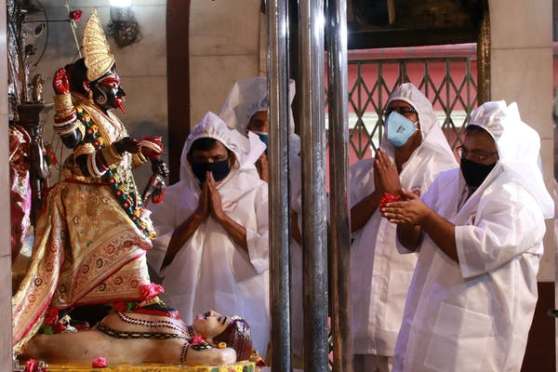Kali is not alien to Sinhala-Buddhism
Why Dhammika Bandara invoking the Hindu Goddess shouldn’t be a big surprise
By P. K. Balachandran
COLOMBO – Mano Ganeshan, a Colombo-based Hindu Tamil leader, had recently criticized the Sinhalese Buddhist Shaman, Dhammika Bandara, for marketing a potion which, he claimed, would prevent people from contracting the COVID-19 virus as it is imbued with the spirit of the powerful Hindu Goddess Kali.
Ganeshan used his twitter handle to ask if Bandara and his masters intended to establish a “Kaliyamma Nikaya” and urged his followers to fight the “frauds who try to claim credit by using the name of Goddess Kali”. Ganeshan identified himself as the “immediate former Minister for Hindu affairs & Tamil Sri Lankan political leader”.
While Ganeshan is fully entitled to air his opposition to the use of Hindu symbolism or deities for marketing a product, however noble the intention may be (in this case to stop the coronavirus from spreading), he is wrong if he means the Hindus have a sole claim over Kali.
Renowned anthropologists like Gananath Obeysekere, Richard Gombrich and Wimal Hewamanage, have written with authority on the important place occupied by Kali in Sinhala Buddhist religious and cultural practice. Kali, like the Tamil deities Pattini and Murugan (Skanda), is part and parcel of Sinhala Buddhism as she is of Hinduism. She is part of the Buddhist pantheon. In both India and Sri Lanka, Kali is widely invoked by both Hindus and Buddhists, to fight diseases and overcome misfortunes both collective and individual. Hewamanage even cites a Mantram or chant intoned in the Kali kovil in Munneswaram, in which Islamic beliefs are incorporated in the Arabic language.
Tulasi Srinivas, Professor of Anthropology, Religion and Transnational Studies, Institute for Liberal Arts and Interdisciplinary Studies, Emerson College, Boston, notes in her paper that during the pandemic-induced lockdown in India, “science and faith are not seen as inimical to one another, but as working together, hand-in-glove.” Hindu priests, she said, have designed Kali idols giving her a mask and putting syringes and other medical instruments in her 16 hands, in place of the traditional swords and other weapons of destruction.
In his paper: The History of the Kāli Cult and its Implications in Modern Sri Lankan Buddhist Culture, in the Alternative Spirituality and Religion Review (2018) Wimal Hewamanage of Colombo University shows that Kali is seen in Sri Lanka as a mother Goddess like Lakṣhmi, Durgā, and Saraswati. But unlike these deities, Kali is depicted with a lolling tongue and other fantastical attributes.
The Kali cult is but part of the Pattini cult, and both cults came from South India. When Buddhism and Jainism went into decline in South India between the 8th and the 13th centuries, Buddhists, who were pushed out of South India, settled on Sri Lanka’s western coast, in Puttalam to be precise.
In South India, especially Kerala, the Kali cult was part of the Pattini cult, which in turn was part of the cults of Durgā or Bhagavati. But the Sinhala Buddhists made a slight modification in this line up. They separated Kali from the rest and saw her as a folk deity rather than as a mainstream Goddess. As Hewamanage points out, the main reason for the separation was that the iconography of Kali represented blackness, intolerance, evil, and danger—factors that did not gel with pacifistic Buddhist ideology. However, given her growing popularity, over time, Kali began to be transformed from a demon to a Goddess, he adds.
The Sinhalese believe there are seven forms of Kāli: i) Bhadrakāli; ii) Mahābhadrakāli; iii) Pēnakāli; iv) Vandurukāli (Hanumāpatrakāli); v) Rīrikāli; vi) Sohonkāli; and vii) Ginikāli.
The Munneśwaram kovil complex is one of the main centers of Kali worship in Sri Lanka. It attracts Sinhalese Buddhists and Hindus alike. The complex has shrines for Śiva, Gaṇeśa, Ayyanāyaka, Kāli, and the Buddha. The Kāli temple here is very popular among both communities.
Anthropologist Obeyesekere refers to a Sinhalese Buddhist myth, according to which, when Kāli came from South India and landed at Chilaw near Munnēśvaram, she started devouring human beings. But Pattini, already established as a Sinhalese goddesses in the island by then, prevented her from indulging in such violence. Kāli then became Pattini’s maid. Obeysekere points out that Kali’s duties, as outlined in the ritual called ‘Killing and Resurrection’ (Marāipæddīma), are exactly the same as those of any servant in a Sinhala household.
The Mōdara temple in North Colombo, is one of the most famous Kāli kovils among Sinhala-Buddhists. The Kali here is named Sohon-kāli. Hewamanage notes that although the names of the other Gods’ shrines (like those for Vishṇu and Siva) are written in Tamil, Sohon-kāli’s name is written in Sinhala. Troubled souls and those with health, familial and business issues make a beeline for this shrine.
Mantras (incantations) and Yantras are part of Kali worship. Yantras are designs which are used as instruments to help utilize resources lying in the depths of the worshiper’s subconscious. According to Hewamanage, Hindus, Buddhists and also Muslims, use Mantras and Yantrasin Kali worship.
The Mantras are in Sanskrit, Tamil, and Sinhalese. And since Muslims also flock to the Kali temple to solve their secular problems, one of the Mantras is partly in Arabic demonstrating the syncretic nature of Sri Lanka’s culture.
According to Hewamanage, the Arabic mantra, which, like many Mantras, is to be recited 108 times, goes like this: “Bisibillārahimānarahim, ākunp ayark undi dālām ata hārī mukkumukaa libādan kubādan mohanmat lāilāi llallā mohemmad sulallāhi.”
However, devotees are given the option to drop the Islamic part, if they want to.
-P K. Balachandran is a senior Colombo-based journalist who in the past two decades, has reported for The Hindustan Times, The New Indian Express and the Economist


